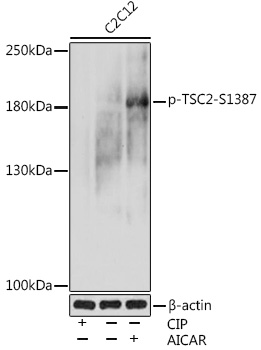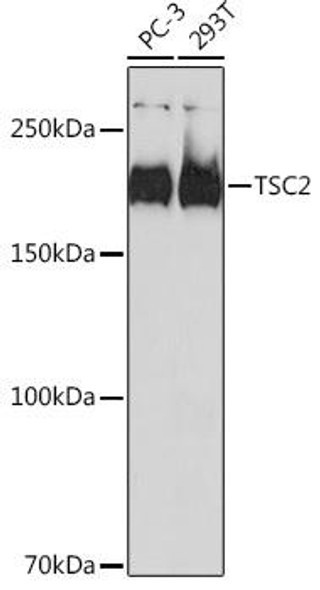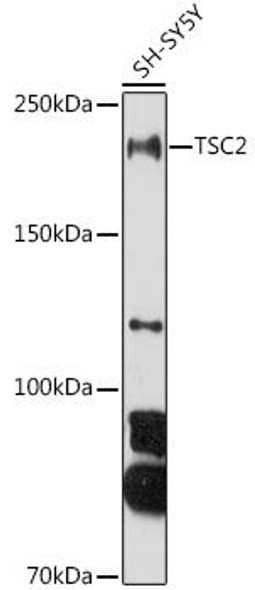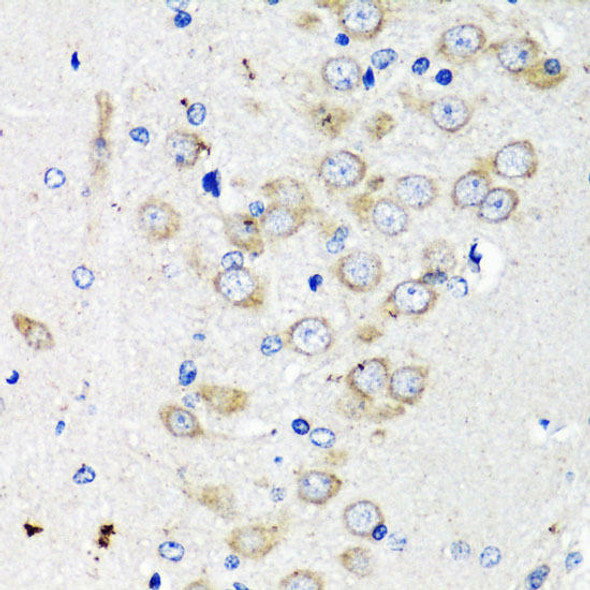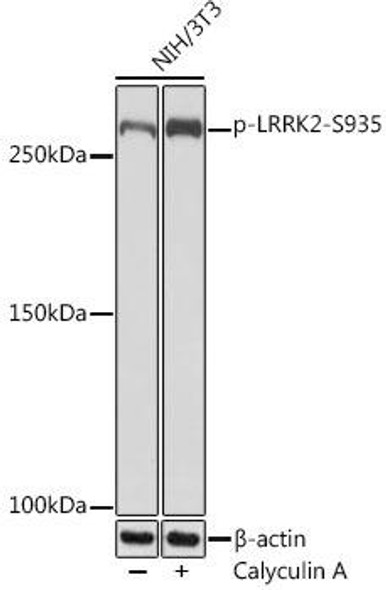Description
Anti-Phospho-TSC2-S1387 Antibody (CABP1117)
The Phospho-TSC2 (S1387) Polyclonal Antibody (CABP1117) is a valuable tool for researchers studying the TSC2 protein, a key regulator of cell growth and proliferation. This antibody, raised in rabbits, specifically detects phosphorylation at serine 1387 of the TSC2 protein and is highly reactive with human samples. Validated for use in Western blot applications, the antibody allows for precise detection and analysis of TSC2 phosphorylation in various cell types.TSC2, also known as tuberin, is a tumor suppressor protein that acts as a negative regulator of the mTOR signaling pathway. Phosphorylation of TSC2 at serine 1387 is a critical event that modulates its activity, influencing cell growth and metabolism.
Research into the phosphorylation status of TSC2 can provide insights into the dysregulation of mTOR signaling in diseases like cancer and tuberous sclerosis complex (TSC).By using the Phospho-TSC2 (S1387) Polyclonal Antibody, researchers can unravel the complex signaling networks involving TSC2 phosphorylation and its impact on cellular processes. This antibody is an essential tool for studies in cancer biology, cell signaling, and the development of targeted therapies aimed at modulating the mTOR pathway. Gain a deeper understanding of TSC2 function and its implications in disease pathology with the reliable detection capabilities of the CABP1117 antibody.
| Antibody Name: | Anti-Phospho-TSC2-S1387 Antibody |
| Antibody SKU: | CABP1117 |
| Antibody Size: | 20uL, 50uL, 100uL |
| Application: | WB |
| Reactivity: | Human, Mouse, Rat |
| Host Species: | Rabbit |
| Immunogen: | A phospho specific peptide corresponding to residues surrounding S1387 of human Tuberin/TSC2. |
| Application: | WB |
| Recommended Dilution: | WB 1:500 - 1:2000 |
| Reactivity: | Human, Mouse, Rat |
| Positive Samples: | C2C12 |
| Immunogen: | A phospho specific peptide corresponding to residues surrounding S1387 of human Tuberin/TSC2. |
| Purification Method: | Affinity purification |
| Storage Buffer: | Store at -20°C. Avoid freeze / thaw cycles. Buffer: PBS with 0.02% sodium azide, 50% glycerol, pH7.3. |
| Isotype: | IgG |
| Sequence: | Email for sequence |
| Gene ID: | 7249 |
| Uniprot: | P49815 |
| Cellular Location: | Cytoplasm, Membrane, Peripheral membrane protein |
| Calculated MW: | 25kDa/187-200kDa |
| Observed MW: | 200kDa |
| Synonyms: | TSC2, LAM, PPP1R160, TSC4, tuberin |
| Background: | Mutations in this gene lead to tuberous sclerosis complex. Its gene product is believed to be a tumor suppressor and is able to stimulate specific GTPases. The protein associates with hamartin in a cytosolic complex, possibly acting as a chaperone for hamartin. Alternative splicing results in multiple transcript variants encoding different isoforms. [provided by RefSeq, Jul 2008] |
| UniProt Protein Function: | TSC2: a product of the tumor suppressor gene TSC2. Tuberin and Hamartin (TSC1) form a tumor suppressor heterodimer that inhibits the mTOR nutrient signaling input. TSC1/TSC2 targets the small G protein Rheb, a novel mediator of the nutrient signaling input to mTOR. Functions as a Rheb GTPase activating protein (GAP). Four alternatively spliced isoforms have been described. |
| UniProt Protein Details: | Protein type:Cell cycle regulation; GAP; GAP, misc.; Nuclear receptor co-regulator; Tumor suppressor Chromosomal Location of Human Ortholog: 16p13.3 Cellular Component: cytoplasm; cytosol; Golgi apparatus; lysosome; membrane; nucleus; perinuclear region of cytoplasm; TSC1-TSC2 complex Molecular Function:GTPase activator activity; phosphatase binding; protein binding; protein homodimerization activity; small GTPase binding Biological Process: anoikis; cell cycle arrest; endocytosis; heart development; insulin-like growth factor receptor signaling pathway; negative regulation of cell proliferation; negative regulation of insulin receptor signaling pathway; negative regulation of phosphoinositide 3-kinase cascade; negative regulation of protein kinase activity; negative regulation of protein kinase B signaling cascade; negative regulation of TOR signaling pathway; negative regulation of Wnt receptor signaling pathway; neural tube closure; positive chemotaxis; positive regulation of macroautophagy; protein import into nucleus; protein kinase B signaling cascade; protein localization; regulation of cell cycle; regulation of endocytosis; regulation of insulin receptor signaling pathway; vesicle-mediated transport Disease: Focal Cortical Dysplasia Of Taylor; Lymphangioleiomyomatosis; Tuberous Sclerosis 2 |
| NCBI Summary: | Mutations in this gene lead to tuberous sclerosis complex. Its gene product is believed to be a tumor suppressor and is able to stimulate specific GTPases. The protein associates with hamartin in a cytosolic complex, possibly acting as a chaperone for hamartin. Alternative splicing results in multiple transcript variants encoding different isoforms. [provided by RefSeq, Jul 2008] |
| UniProt Code: | P49815 |
| NCBI GenInfo Identifier: | 269849475 |
| NCBI Gene ID: | 7249 |
| NCBI Accession: | P49815.2 |
| UniProt Secondary Accession: | P49815,O75275, Q4LE71, Q8TAZ1, A7E2E2, B4DIL8, B4DIQ7 B4DRN2, B7Z2B8, C9J378, |
| UniProt Related Accession: | P49815 |
| Molecular Weight: | 25,773 Da |
| NCBI Full Name: | Tuberin |
| NCBI Synonym Full Names: | tuberous sclerosis 2 |
| NCBI Official Symbol: | TSC2 |
| NCBI Official Synonym Symbols: | LAM; TSC4; PPP1R160 |
| NCBI Protein Information: | tuberin |
| UniProt Protein Name: | Tuberin |
| UniProt Synonym Protein Names: | Tuberous sclerosis 2 protein |
| Protein Family: | Tuberin |
| UniProt Gene Name: | TSC2 |


